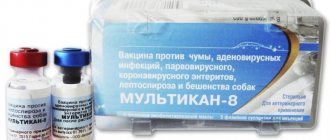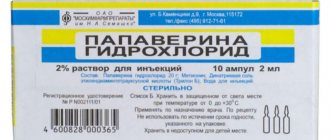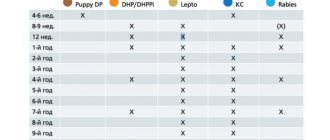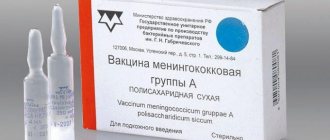Release form, packaging and composition of the drug Clinical-pharmacological group Pharmaco-therapeutic group Pharmacological action Indications for use Method of administration and doses Side effects Contraindications for use Use in children Special instructions Drug interactions
Registration Certificate Holder:
SANOFI PASTEUR, SA (France)
ATX Code:
J07CA02
Active substance:
Dosage form:
Tetraxim
| The drug is available with a prescription | Tetraxim | Suspension for intramuscular administration reg. No.: LP-000548 dated 05/12/11 - Cancellation of State. registration Date of re-registration: 05.17.16 |
Compound
The composition of 1 immunizing vaccine (0.5 ml of suspension for intramuscular administration) includes the following active ingredients:
- at least 30 IU of diphtheria toxoid;
- at least 40 IU of tetanus toxoid;
- 25 mcg pertussis toxoid;
- 25 μg filamentous hemagglutinin (FHA);
- 40 D-units of antigen - inactivated polio virus type 1;
- 8 D-units of antigen - inactivated polio virus type 2;
- 32 D-units of antigen - inactivated poliovirus type 3.
In addition, there are constituent auxiliary substances:
- 0.3 mg aluminum hydroxide;
- 0.05 ml Hanks' medium 199 (without phenol red);
- 12.5 mg formaldehyde;
- 2.5 µl phenoxyethanol 2;
- d/i water – to bring to 0.5 ml;
- ethanoic acid or sodium hydroxide - to achieve a pH value of 6.8-7.3.
Pharmacodynamics and pharmacokinetics
Immune response after primary vaccination
As a result of immunogenicity studies, it was found that the entire group of newborns (100%) vaccinated with 3 doses of the vaccine, starting at the age of 2 months, developed a seroprotective antibody titer (more than 0.01 IU/ml) against diphtheria and tetanus .
More than 87% of children younger than 1-2 months. after the completion of the primary course of immunization, an increase in the titer of antibodies against pertussis toxoid and PHA by 4 times.
99.5% of children after primary vaccination had a protective antibody titer against polio types 1,2,3.
After the first dose of revaccination at 16-18 months. all children had protective antibodies against diphtheria (more than 0.1 IU/ml), tetanus (more than 0.1 IU/ml) and 87.5% against the polio .
Seroconversion rates for pertussis (titers are 4 times higher compared to titers for vaccination) are 92.6% for pertussis toxoid and 89.7% for PHA .
Immune response after revaccination
As a result of revaccination, all children aged 5-13 years had protective antibody titers against tetanus (more than 0.1 IU/ml) and polio . Of these, at least 99.6% had protective antibody titers against diphtheria (more than 0.1 IU/ml). Seroconversion rates for pertussis (titers 4 times higher than pre-vaccination titers) ranged from 89.1% to 98% for pertussis toxoid and from 78.7% to 91% for PHA .
pharmachologic effect
Administration of the drug in accordance with the approved regimen forms specific immunity against whooping cough, diphtheria, tetanus and polio.
Immune response after the initial course of vaccination:
Immunogenicity studies conducted in children of the 1st year of life who received 3-fold immunization with the Tetraxim vaccine, starting from the 2nd month of life, demonstrated that all vaccinated people (100%) developed a protective titer of antibodies (>0.01 IU/ml) to diphtheria and tetanus antigens.
With regard to pertussis antigens, approximately 90% of children experienced a 4-fold increase in antibody titers to pertussis toxoid and filamentous hemagglutipin 1-2 months after completion of the primary course of vaccination. Due to the lack of an empirically established serological criterion for protection, a 4-fold increase in antibody titers is considered a criterion for seroconversion.
In at least 99.5% of children after immunization, antibody titers to polioviruses types 1, 2 and 3 exceeded level 5 (the reciprocal of the dilution in the serum neutralization test), which is considered protective against poliomyelitis.
Immune response after revaccination:
Immunogenicity studies conducted in children 2 years of age who received a primary course of vaccination in the form of 3 doses of the Tetraxim vaccine demonstrated a high level of immune response to all components after the 4th dose (booster vaccination).
Studies conducted in children aged 12-24 months who received a primary course of immunization with three doses of vaccines with a whole cell pertussis component demonstrated that subsequent booster vaccination with Tetraxim vaccine is safe and immunogenic for all vaccine components.
Contraindications
- A hypersensitivity reaction to one of the components or an allergic reaction to residues from the manufacturing process that may be present in trace amounts, for example, gutaraldehyde , neomycin , streptomycin , polymyxin B , or to the pertussis acellular or whole-cell component .
- A life-threatening reaction to a previous dose of this vaccine or a vaccine containing similar components.
- In cases of chronic or acute diseases, while receiving immunosuppressive therapy, vaccination should be postponed in an immunosuppressed state.
- Progressive encephalopathy (cerebral lesions) or that occurred 7 days after vaccination with any vaccine with a pertussis component (acellular or whole-cell).
The vaccine is used only in pediatrics!
Can be used with caution
- children with thrombocytopenia or bleeding disorders;
- a history of febrile seizures not associated with previous vaccination requires temperature control for 2 days after vaccination, as well as the use of antipyretics .
Contraindications for use
- progressive encephalopathy, accompanied by or without seizures;
- encephalopathy that developed within 7 days after. previous administration of any vaccine containing Bordetella pertussis antigens;
- a strong reaction that developed within 48 hours after a previous vaccination with a vaccine containing a pertussis component: an increase in body temperature to 40 ° C or higher, a syndrome of prolonged unusual crying for 3 or more hours, febrile or afebrile convulsions, hypotonic-hyporeactive syndrome;
- an allergic reaction that developed after the previous administration of any vaccine for the prevention of diphtheria, tetanus, whooping cough, polio;
- a confirmed allergic reaction to any vaccine ingredient, as well as glutaraldehyde, neomycin, streptomycin and polymyxin B;
- diseases accompanied by an increase in body temperature, acute manifestations of an infectious disease or exacerbation of a chronic disease. In these cases, vaccination should be postponed until recovery.
Carefully :
If a child has a history of febrile seizures that are not associated with previous vaccination, the vaccinated person’s body temperature should be monitored for 48 hours after vaccination and, if it increases, antipyretic (antipyretic) drugs should be used during this period.
Side effects
Local reactions
On the third day, pain, redness, and hardness may occur at the injection sites. Such reactions resolve spontaneously without treatment. In some cases, thickening and redness may occur, exceeding 5 cm in diameter and accompanied by swelling, spreading to one or two joints over 2-3 days, which also disappears spontaneously after 3-5 days without additional treatment.
General reactions
With a frequency of 1-10%, an increase in temperature to 38°-39°C is observed. In rare cases (less than 1%), the rectal temperature rose above 40°C.
Other reactions
- irritability, sleep disturbances, drowsiness;
- loss of appetite, vomiting, diarrhea;
- unusual or prolonged crying;
- rash, urticaria , Quincke's edema ;
- convulsions (febrile and afebrile);
- hypotension, hypotonic-hyporeactive syndrome , shock;
- Guillain-Barré syndrome , neuritis (inflammation) of the brachial nerve;
- prolongation of inhalation-exhalation intervals in very premature (≤28 weeks) children (requires monitoring of respiratory function for 48-72 hours).
special instructions
Parents of children who have been administered Tetraxim should inform their doctor about the occurrence of any adverse reactions, including those not described in the instructions for use.
To avoid the development of allergic reactions, before each vaccination, the doctor must clarify the child’s health status, the history of his immunization and illnesses (including allergy history), and also find out whether there have been any cases of side effects with previous administrations of any vaccines. The vaccination room must be equipped with medications and instruments necessary to eliminate hypersensitivity reactions.
In conditions of immunodeficiency and immunosuppressive therapy, a decrease in the immune response to the administration of Tetraxim is possible. It is recommended to postpone vaccination of such children until the disease is in remission or therapy is completed. However, in patients with chronic immunodeficiency (for example, HIV-infected patients), vaccination is recommended even if the immune response is likely to be weakened.
The suspension should be administered with caution to patients with thrombocytopenia and other bleeding disorders, as there is a risk of bleeding during injection.
Very preterm infants (born at or before 28 weeks' gestation) are at potential risk of developing apnea, especially if there is a history of respiratory immaturity. Such children need to have their breathing monitored for 48–72 hours after administration of the vaccine. The benefits of immunization outweigh the possible risks, so you should not delay or refuse vaccination.
The decision to prescribe Tetraxim to children in whom the administration of any vaccine containing tetanus toxoid has caused the development of brachial neuritis or Guillain-Barré syndrome should be made by the attending physician, carefully assessing the balance of benefits and possible risks. In such cases, completing the primary immunization (if fewer than three doses have been administered) is usually warranted.
Impact on the ability to drive vehicles and complex mechanisms
Tetraxim is used only in young children, so studies on the effect of the vaccine on the speed of reactions and the ability to concentrate have not been conducted.
Tetraxim, instructions for use (method and dosage)
Vaccination should be carried out by medical personnel in preventive vaccination rooms of medical institutions, where all the necessary medications are available to provide emergency medical care in the event of the development of serious allergic reactions, including anaphylactic shock .
Immediately before vaccination, shake the vaccine to form a homogeneous whitish cloudy suspension. The drug should be administered in a dose of 0.5 ml intramuscularly, making sure that the needle does not enter the vessel.
The recommended injection site for children under 1 year of age is the anterolateral surface of the thigh (middle third), for older children - the densest part of the deltoid muscle of the shoulder.
Immunization schedule
Must be observed in accordance with the preventive vaccination calendar:
- 3 injections with an interval of 1.5 months, starting at 3 months of age 3, and then at 4.5 and 6 months. respectively;
- revaccination after 12 months. by administering a single dose of the vaccine.
Attention!
If the vaccination schedule has been violated, then the intervals between subsequent administrations of subsequent doses of the vaccine should not change, including before the fourth revaccination dose, and be at least 12 months.
Description of the active substance (INN):Vaccine for the prevention of diphtheria, whooping cough, polio, tetanus
Description for the trade name:
Tetraxim
Dosage form:
suspension for intramuscular administration
Pharmacological action:
Immunity is acquired after the second injection of the vaccine, strengthens with subsequent ones and lasts for at least 5 years after the first revaccination.
Seroconversion to diphtheria toxin is observed in 92-100% of vaccinated people, to tetanus toxin - in 100%, to pertussis toxin - in 93% and to polio virus - in 100%. Indications:
Diphtheria, whooping cough, tetanus, polio (prevention): primary vaccination of children from 2 months;
revaccination of children from 2 years of age. Contraindications:
Hypersensitivity (including to previous vaccine administration), severe reaction to previous vaccine administration (increased body temperature to 40 degrees C and above, prolonged crying syndrome, convulsions, including febrile, hypotonic-hyporeactive syndrome (if these reactions occurred within 48 hours after vaccination) Progressive encephalopathy (including those accompanied by convulsions)
Side effects:
Local (may develop within 48 hours after vaccination and persist for several days): soreness, hyperemia , hardening or swelling of soft tissues at the injection site. These reactions may be accompanied by the formation of a subcutaneous nodule that persists for several weeks. Rarely - a sterile abscess. General (in the first 24-48 hours after injection): an increase in body temperature above 38.5 degrees C (not more than 5% of vaccinated people), prolonged unusual crying. Allergic reactions: rash, urticaria, rarely - anaphylactic shock, Quincke's edema (like urticaria with rapidly developing swelling of the face and neck).
Rarely - hypotonic-hyporeactive syndrome, prolonged crying syndrome, febrile or afebrile convulsions, acute encephalopathy. Method of administration and dosage:
IM into the anterolateral surface of the thigh (middle third) according to the following scheme: primary vaccination, consisting of 3 injections - 0.5 ml each with an interval of at least 1 month.
The regimen for using the drug is determined by the national calendar of preventive vaccinations: in accordance with the national calendar of preventive vaccinations of the Russian Federation, primary vaccination against diphtheria, tetanus, whooping cough and polio is carried out in 3 doses administered at intervals of 1.5 months (3 months, 4.5 months and 6 months). . Revaccination: once 1 year after the 3rd dose of primary vaccination. In accordance with the national calendar of preventive vaccinations of the Russian Federation, revaccination is carried out once at the age of 18 months (if the vaccination schedule is violated, 12-13 months after the last vaccination with DTP vaccine). Special instructions:
Do not administer intravenously or intravenously!
Before insertion, make sure that the needle does not penetrate the blood vessel. In accordance with WHO recommendations, the vaccine can be used to immunize children infected with the human immunodeficiency virus and at any stage of the disease (with or without clinical manifestations). In accordance with the National Calendar of Preventive Vaccinations of the Russian Federation, primary vaccination against diphtheria, tetanus, whooping cough and polio is carried out from 3 months of age, and revaccination at the age of 18 months. The vaccine can be used up to 6 years of age inclusive. In the Russian Federation, such vaccination is carried out until the age of 3 years 11 months 29 days. Immunosuppressive therapy or immunodeficiency may cause a reduced immune response to the vaccine. The drug is not suitable for use in syringes or vials with damaged integrity, lack of labeling, changes in physical properties (change in color, presence of sediment that does not disappear when shaken), expired, or improperly stored. Tetracok can be used simultaneously with any other vaccine. In this case, vaccines are administered to different parts of the body using different syringes and needles. The doctor should be informed about recent or contemporaneous treatment with any drug (even over-the-counter). At intervals between doses and no later than 5 minutes after the last dose, the bottle must be placed in the refrigerator (but not in the freezer) for storage at a temperature of 2-8 degrees C. The manufacturer's responsibility regarding the declared characteristics of the drug extends before its use. Neurological disorders due to vaccination are most often caused by the pertussis component of the vaccine. As a rule, adverse reactions are mild and quickly passing, especially if NSAIDs, barbiturates or antihistamines are prescribed preventively. Interaction:
The vaccine can be mixed in the same syringe with monovalent conjugate vaccine for the prevention of Haemophilus influenzae type b (Hib). In this case, Tetracok is used as a diluent for lyophilized Hib vaccine.
The description of the drug Tetraxim is not intended for prescribing treatment without the participation of a doctor.
Interaction
- Tetraxim can be administered simultaneously with the measles , mumps and rubella or with the hepatitis B , provided that it is administered to different parts of the body.
- For primary immunization as a booster, Tetraxim vaccine can be used as a vaccine diluent to prevent infections associated with Haemophilus influenzae type b (Act-HIB), or simultaneously in different places on the body.
Before vaccination, tell your doctor if you are using any medications.
Drug interactions
With the exception of immunosuppressive therapy, there is no reliable data on the possible mutual influence when used with other drugs. The vaccine can be administered in the same syringe with the conjugate vaccine against infection caused by Haemophilus influenzae type b (Act-HIB) (in this case, the Act-HIB vaccine is diluted directly with the vaccine Tetraxim), or simultaneously with this vaccine (in different parts of the body). Rarely, when administered simultaneously with vaccines containing the Hib component, cases of edema of one or both lower extremities were observed (in the case when two vaccines are administered with one syringe, with a predominance of edema limb into which the vaccine was injected). Swelling was mainly observed during the first few hours after primary vaccination. These reactions were sometimes accompanied by increased body temperature, soreness, prolonged crying, cyanosis or change in skin color, less often redness, petechiae or transient purpura, increased body temperature, and rash. These reactions resolved spontaneously within 24 hours without any residual effects, they were not associated with any adverse events from the heart or respiratory system. Tetraxim can be administered simultaneously with vaccines against measles-mumps-rubella, chickenpox, hepatitis B to different parts of the body. The doctor should be informed about the recent or coincidental administration of any other drug to the child (including over-the-counter drugs).
Analogs
Level 4 ATX code matches:
Pentaxim
Infanrix Hexa
Infanrix
- Pentaxim (additionally immunization against Hib infection ).
- Boostrix Polio - used only in children over 4 years of age.
- Hexaxim - immunization differs in the vaccine administration schedule: it starts at 6 weeks of age, the interval between the next three doses of vaccines is 4 weeks, 1 month or 2 months.
Price and reviews about vaccination
The cost of the drug Tetraxim in Russian pharmacies can vary from 2000 to 3500 rubles. Everything will depend on the location of the pharmacy, as well as on the pricing policy pursued by the seller.
In some medical institutions, the drug can be purchased along with the immunization service. There are not many reviews about this drug on the Internet. But the majority of them are positive.
Here are some of the reviews:
- Marina, 25 years old . We vaccinated our son against whooping cough, diphtheria and tetanus with the French Tetraxim vaccine. Everything went well. We were satisfied. No side effects or complications;
- Olga Vasilievna, 54 a. We vaccinated our granddaughter using Tetraxim. The baby was naughty all evening. But, in fact, this is where the whole set of side effects ended. In the morning everything was already fine. There were no terrible complications that the doctor threatened. So it’s a very good vaccine;
- Katya, 31 years old. I liked the Tetraxim vaccine. We vaccinated our daughter in a private clinic because there was not a single DTP vaccine in the city. Instead, we were offered to be vaccinated with Tetraxim, additionally providing the child with reliable immune protection against polio. We did it and didn’t regret it. I liked the clinic too. Now if we get vaccinated, it will only be there.
Reviews of Tetraxim
Reviews about this vaccine are positive: many mothers report that vaccination and revaccination were successful; some children experienced a slight increase in temperature on the second day, which went away on its own.
Parents just planning immunization are interested in the differences between Tetraxim and Pentaxim , as well as Infanrix , which, although they are analogues, differ in the number of components they contain for protection and are tolerated differently by children. All necessary protection components can be obtained in the form of separate injections. Pentaxim has the largest number of them (additionally for Hib infection ), but this provokes a more frequent development of undesirable reactions.
Normal reaction and side effects
Usually, vaccination using Tetraxim suspension is tolerated without any complications.
In some cases, it is still possible that more or less severe reactions to the drug introduced into the body may occur. It could be:
- redness, swelling of the skin or itching at the injection site;
- loss of appetite;
- sleep disturbance or, on the contrary, drowsiness;
- lethargy;
- irritability;
- temperature rise to 37 C.
As a rule, the listed reactions are considered natural. They usually go away in the first two to three days and do not pose a threat to the health of the vaccinated child.
In addition to those listed above, more serious manifestations are also possible:
- fever caused by an increase in temperature to 38 C or higher;
- seizures;
- swelling of the limbs;
- vomiting and diarrhea;
- severe headaches.
The above-mentioned manifestations are due to the individual characteristics of the body and can harm the child, so if they occur, you should seek help from a doctor.









